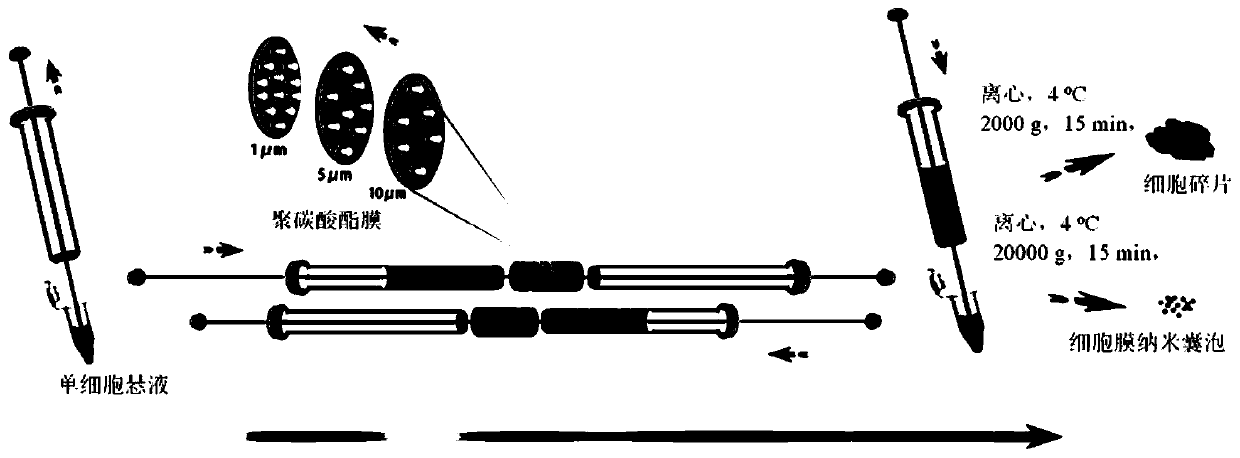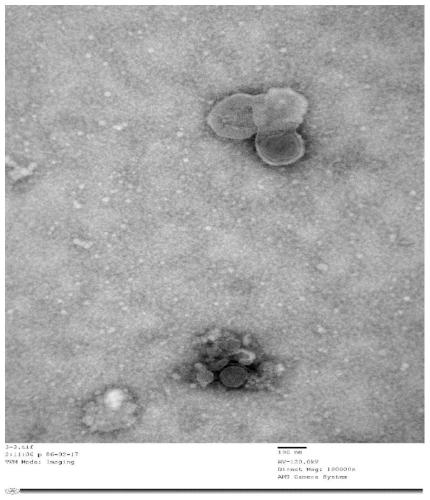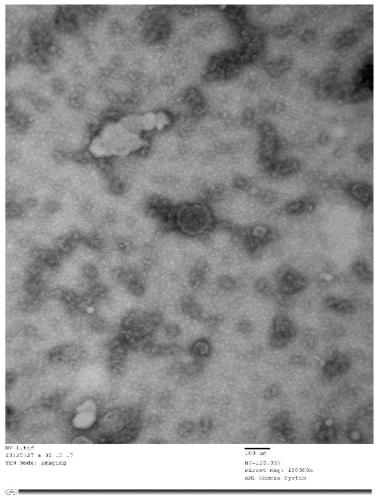Cytomembrane nano-vesicles and production method thereof
A nanovesicle, cell membrane technology, applied in the field of biomedicine, can solve the problems of inability to cross the blood-brain barrier, time-consuming, large particle size, etc., and achieve the effects of good product uniformity, high production yield, and stable vesicle properties.
- Summary
- Abstract
- Description
- Claims
- Application Information
AI Technical Summary
Problems solved by technology
Method used
Image
Examples
Embodiment 1
[0034] Preparation and characterization of cell membrane nanovesicles derived from RAW264.7 cells
[0035] 1. The best preparation method of cell membrane nanovesicles derived from RAW264.7 cells
[0036] The mouse mononuclear macrophage leukemia cell RAW264 used in the present invention was purchased from the Institute of Basic Medical Sciences, Chinese Academy of Medical Sciences. RAW246.7 cells were cultured in a 25T culture flask to 80% density, digested, centrifuged at 800 g for 5 min, discarded the supernatant, and blown the pellet in 1 mL of PBS solution to make a single cell suspension.
[0037] Method I: The cell suspension was continuously extruded 11 times through a 100 μm polycarbonate membrane filter using the Mini Extruder provided by Avanti Polar Lipids, USA. Separation and purification: After centrifugation at 4°C, 20,000g, 15min, take the supernatant at 4°C, 100,000g, ultracentrifuge for 1h, discard the supernatant, and pipette the pellet repeatedly with ster...
Embodiment 2
[0045] 1. Preparation method of NVs derived from umbilical cord mesenchymal stem cells
[0046] Cultivation of umbilical cord Mesenchymal Stem Cells (UMSCs): Rinse the umbilical cord tissue with PBS buffer, cut the tissue into 2cm-3cm sections with sterile scissors, wash the blood clot with PBS buffer, repeat 2 -3 times until the washing liquid is clear. Cut the umbilical cord, remove two arteries and one vein in turn. Trim the tissue to a surface area of approximately 10 mm 2 ~25mm2 tissue block, the colloid side is spread on the bottom of the culture dish, let it stand for 15min~20min, then slowly add an appropriate amount of medium along the side wall, and place it at 37°C, 5% CO 2 cultured in an incubator. When the cell confluence reaches 80%-90%, discard the medium, wash with PBS buffer, add trypsin to digest the cells until most of the cells become round and begin to fall off. Add appropriate amount of culture medium to stop digestion. After the cells were blown a...
Embodiment 3
[0053] 1. Preparation method of cell membrane nanovesicles derived from neural stem cells
[0054] Neural Stem Cells (Neural Stem Cells, NSCs) culture: The tissue used is aborted fetuses (medical waste) at 7-14 weeks of gestation. The cerebral cortex is separated, placed in the complete culture medium of NSCs, and divided into small tissue pieces. Blow and suck 20-30 times, let it stand for 10 minutes, absorb the supernatant, centrifuge at 820rpm for 5 minutes, and discard the supernatant. Add special digestive solution to the precipitation, place the culture dish in an incubator for digestion for 1-2 minutes, centrifuge at 820 rpm for 5 minutes, and discard the supernatant. Add NSCs complete culture solution to the pellet and add it to the centrifuge tube, blow gently for 10-15 times to form a single cell suspension and then inoculate. placed in a carbon dioxide incubator at a temperature of 35°C and CO 2 The concentration is 5%. After the NSCs grow into neurospheres of su...
PUM
| Property | Measurement | Unit |
|---|---|---|
| particle diameter | aaaaa | aaaaa |
| particle size | aaaaa | aaaaa |
| particle size | aaaaa | aaaaa |
Abstract
Description
Claims
Application Information
 Login to View More
Login to View More - R&D
- Intellectual Property
- Life Sciences
- Materials
- Tech Scout
- Unparalleled Data Quality
- Higher Quality Content
- 60% Fewer Hallucinations
Browse by: Latest US Patents, China's latest patents, Technical Efficacy Thesaurus, Application Domain, Technology Topic, Popular Technical Reports.
© 2025 PatSnap. All rights reserved.Legal|Privacy policy|Modern Slavery Act Transparency Statement|Sitemap|About US| Contact US: help@patsnap.com



